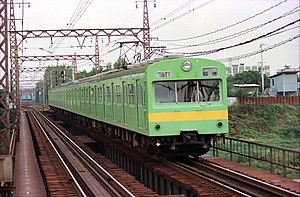You can helpexpand this article with text translated fromthe corresponding articlein Japanese.(July 2022)Click [show] for important translation instructions.
|
The101 series(101 hệ,101-kei)was a DCelectric multiple unit(EMU) commuter train type introduced in 1957 byJapanese National Railways(JNR), and formerly operated byEast Japan Railway Company(JR East) andWest Japan Railway Company(JR-West). The last remaining trains were withdrawn in November 2003.
| 101 series | |
|---|---|
 JNR 6-car set atAsaka Stationon theHanwa Line,1978 | |
| In service | 1957–2003 |
| Replaced | 72 series |
| Constructed | 1957–1969 |
| Entered service | December 1957 |
| Scrapped | 1987–2014 (not all parts are fully scrapped, other remaining parts such as pantographs are still in use in other rolling stocks such as121 series/7200 series[1]& remodeled 145 series converted from old 101 series EMUs) |
| Number built | 1,535 vehicles |
| Number in service | None (44 vehicles being converted into 145 series multiple locomotive) |
| Number preserved | 2 vehicles |
| Number scrapped | 1,489 vehicles |
| Successor | 103 series,205 series,207 series |
| Formation | 2, 3, 6, 7, 8 or 10 cars per trainset |
| Operators | JNR(1957–1987) JR East(1987–2003) JR-West(1987–1992) Chichibu Railway(1986–2014) |
| Specifications | |
| Car body construction | Steel |
| Car length | 20,000 mm (65 ft 7 in) |
| Width | 2,879 mm (9 ft 5.3 in) |
| Doors | 4 pairs per side |
| Maximum speed | 100 km/h (62 mph) |
| Traction system | Resistor control |
| Traction motors | MT46 |
| Power output | 100 kW (134 hp) |
| Acceleration | 2.0 km/(h⋅s) (1.2 mph/s) (7-car formation) 3.2 km/(h⋅s) (2.0 mph/s) (all motored cars) |
| Deceleration | 3.0 km/(h⋅s) (1.9 mph/s) (service, 7-car set) 3.5 km/(h⋅s) (2.2 mph/s) (emergency) |
| Electric system(s) | 1,500 V DCoverhead catenary |
| Current collector(s) | Pantograph |
| Bogies | DT21, DT21T, TR64 |
| Track gauge | 1,067 mm(3 ft 6 in) |
History
editThe prototype 101 series set was delivered in June 1957, as a 10-car (4+6-car) set classified as 90 series with all cars motored. Cab cars were numbered MoHa 90500 to 90503, and the intermediate cars were numbered MoHa 90000 to 90005. Production sets were delivered from March 1958, differing visually from the prototype in having exposed rain gutters along the top of each car. The 90 series was reclassified as 101 series from 1959, with the prototype set cars numbered in the 900 subseries. The prototype set was modified in 1962 to bring it up to production set standards.[2]
Lines used
edit101 series trains operated on the following lines.
Tokyo Area
edit- Chūō Line (Rapid)(1957-1985)
- Itsukaichi Line(1978-1985)
- Keihin-Tohoku Line(1970-1978)
- Musashino Line(1973-1986)
- Nambu Line(1969-1991 for commuter rail services; 1980 - November 2003 for Branch line services)
- Chūō-Sōbu Line(1963-1988)
- Tsurumi Line(1980-1992)
- Yamanote Line(1961-1968)
- Akabane Line(Now Saikyō Line) (1967-1978)
Osaka Area
edit- Kansai Main Line
- Katamachi Line(1976-1992)
- Osaka Loop Line(1964-1991)
- Sakurajima Line(1961-1991)
-
JNR 101 series EMU approaching Kinshicho Station atChuo-Sobu Line,August 1978
-
A JNR 101 series EMU leaving Katamachi Station on theKatamachi Line,1985
-
JR East 3-car Tsurumi Line set at Musashi-Shiraishi Station, circa December 1990
-
A JR East 2-car Nambu Branchline set at Shitte Station in July 2002
-
Last standing 101 series with "Sayonara" head mark on its last run on Nambu Branch Line Services in December 2003
Private operators
editA number of former 101 series trains were sold to theprivate railwayoperatorChichibu RailwayinSaitama Prefecturein 1986, where they operated as 3-car1000 seriessets until March 2014.
-
A Chichibu Railway 1000 series set in January 2008
-
Chichibu Railway 1000 series sets in "revival" JNR liveries in December 2007
Preserved examples
edit- KuMoHa 101-902 is preserved atThe Railway MuseuminSaitama,previously preserved at JR East's Tokyo General Rolling Stock Center.[3]
- A 101 seriesmock-upcar is exhibited at theKyoto Railway Museum.[4]
-
KuMoHa 101-902 at Tokyo General Rolling Stock Center, August 2005
-
Mock-up of a 101 series at the Kyoto Railway Museum, April 2017
References
edit- JR toàn xa lượng ハンドブック'93[JR Rolling Stock Handbook 1993]. Japan: Neko Publishing. 1993.
- JR điện xa biên thành biểu '98 hạ hào[JR EMU Formations - Summer 1998]. Japan: JRR. July 1998.ISBN978-4-88283-029-0.
- ^Fukuhara, Shunichi (September 2016).121 hệ cận giao hình trực lưu điện xa のあゆみ part2[The history of the 121 series suburban DC EMU trains (part 2)].Japan Railfan Magazine(in Japanese). Vol. 56, no. 665. Japan: Koyusha Co., Ltd. pp. 94–99.
- ^プロトタイプの thế giới - Prototype World.Japan: Kōtsū Shimbunsha. December 2005.OCLC170056962.
- ^Railway Museum exhibit detailsArchived6 March 2009 at theWayback Machine.Retrieved 28 April 2009.(in Japanese)
- ^"Tối hậu の “Quốc thiết トラック điện xa” JR tây nhật bổn クモル145・クル144 hình とは まもなく hoàn lịch に ( tả chân 37 mai ) "[The last "JNR track train", JR West Kumoru 145 and Kuru 144, will soon have their 60th birthday (37 photos)].trafficnews.jp(in Japanese). Mediavague Co., ltd. 22 December 2017.Archivedfrom the original on 9 December 2019.Retrieved9 December2019.
External links
edit- "JR East 101 series".jreast.co.jp(in Japanese). Archived fromthe originalon 4 February 2004.Retrieved27 October2011.